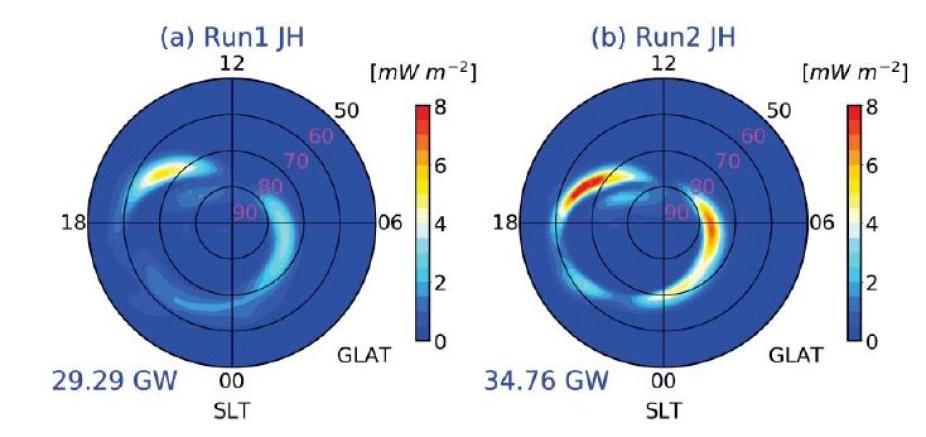Publication Name: JGR Space Physics; First HAO Author's Name: Art Richmond
The Earth’s atmosphere is coupled at high latitude to the magnetosphere. This is a crucial region since energy is put into the upper atmosphere of Earth and is redistributed globally. Numerical models such as general circulation models (GCMs) simulate the effects of the high latitude energy input on the thermosphere-ionosphere system.

Distributions of height-integrated Joule heating in the northern hemisphere (geographic coordinates) from two GITM simulations for 2002 September 23 0010 UT: (a) Run 1 with static boundary binning and (b) Run 2 with boundary oriented binning. The hemispherically integrated Joule heating is given at the lower left of each plot. There is an 18% increase in integrated heating when employing the boundary oriented binning method.
However, an outstanding issue in the GCM simulations for Earth’s upper atmosphere is the inaccurate estimation of energy input, especially the Joule heating, which is associated with the inaccuracy of empirical models for high-latitude electrodynamic forcing. Several factors can contribute to the inaccuracy. In this study, we examine the influence of the binning methods used in the development of those empirical models on the Joule heating. Traditionally, data under similar conditions are binned through a static binning approach by using fixed geomagnetic coordinates, in which the dynamic nature of the forcing is not taken into account and therefore the forcing patterns may be significantly smoothed. To avoid the smoothing issue, data can be binned according to some physically important boundaries in the high-latitude forcing, i.e., through a boundary-oriented binning approach. In this study, we have investigated the sensitivity of high-latitude forcing patterns to the binning methods by applying both static and boundary-oriented binning approaches to the electron precipitation and electric potential data from the Defense Meteorological Satellite Program (DMSP) satellites. The forcing patterns obtained from both static and boundary-oriented binning approaches are used to drive Global Ionosphere and Thermosphere Model (GITM) to assess the impacts on Joule heating by using different binning patterns. It is found that the hemispheric-integrated Joule heating in the simulation driven by the boundary oriented binning patterns is 18% higher than that driven by the static binning patterns for southward IMF dominated case.